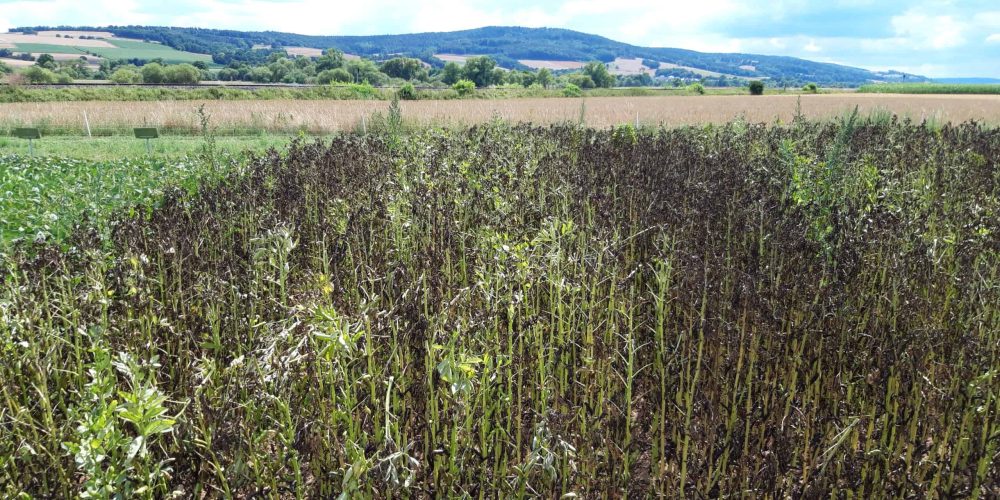Table of contents of the article
ToggleChocolate spot on bean leaves is one of the most dangerous fungal diseases that affect bean leaves, affecting the quality of the crop. In this article on your website, World of Plants, we will review methods of prevention and control.
Symptoms of chocolate spot on bean leaves
Name of the disease: Chocolate Leaf Spot in Broad Bean
Scientific name: Botrytis fabae Sard
Type: innate
Disease family: Sclerotiniaceae
Symptoms of infection appear on old leaves, and then spread to... The upper leaves are in the form of spots Their color is reddish, turning to brown as the infection progresses. These spots take a circular shape and are scattered between the veins of the leaves. When exposed to sunlight in front of the face, a network of threads appears in the center of these spots, their color similar to the color of cocoa powder. The same symptoms also appear on the stem and leaf petioles, followed by the leaves drying and falling.
Causes of chocolate spot on bean leaves
Remnants of the previous infected crop, high humidity, and dew formation
Suitable conditions for the spread of chocolate spot on bean leaves
The spread of this disease increases in cold, humid weather. High humidity and rainfall or dew are necessary for the germination and spread of the fungus’ reproductive units. Suitable temperatures range from 12 to 18 degrees Celsius.
Development cycle of chocolate spot on bean leaves
The fungus maintains its vitality in the soil in the form of black, stony bodies. It can also be transmitted through the remains of the infected crop, and it is not certain that the disease is transmitted through seeds.
The stone bodies germinate to produce a gametophyte, on which conidial spores are formed when appropriate moisture is available. These spores spread to cause infection on sensitive plants. The fungus grows at an optimum temperature between 15-20 °C, and it is necessary to have a relative humidity higher than 80% for conidial spores to form on the spots. These spores are spread by the wind to cause new infections that spread the disease quickly, starting from the initial infection spots during the crop’s growing season. It appears that the availability of free water on the surface of the plant is not necessary for infection with conidia spores to occur, but it is sufficient to provide a relative humidity higher than 90%. At the end of the growing season, the fungus forms small black stones in the middle of the affected spots.





Losses of disease spread
This disease affects Leaf disease In general, this primarily affects the vegetative system and weakens the growth of the plant. When the infection becomes severe, symptoms appear on the stem, pods and seeds, thus reducing the quantity and quality of production. This disease causes the leaves to fall and causes a loss that may reach 10% of the total production.
Control strategy
- Mechanical control
- Physical control (tillage, sanitation, pruning, solarization)
- Fungicides
Preventive measures to prevent chocolate spot on bean leaves
It is useful to leave an appropriate distance between plants, separate crowded plants, in order to reduce the relative humidity around the leaves, get rid of the remains of infected plants and burn them after harvest, follow an appropriate agricultural cycle, and pay attention to potassium fertilization, which increases the degree of tolerance of plants to infection with the disease.
- Collect the remains of diseased plants from the previous season, remove them from the field, and burn them or bury them by deep plowing to get rid of the source of infection. The fungi and stone bodies of the fungus disappear after four months of burying them to a depth of 20 cm, and not leaving them exposed in the soil. The fungus was isolated from 13% of the diseased plant residues that were left in the field without plowing.
- Moderate irrigation and avoid sprinkler irrigation to avoid the high humidity necessary for the development of the disease.
- Cultivation of varieties Disease tolerant beans. 5. Exposing bean plants to red light, which reduces the infection rate, due to the formation of special anti-fungal substances in the leaves. Such lighting (lamps) can be placed inside protected crops and greenhouses.
Chemical control recommendations
- Metalaxyl.
- Difenoconazole.
In conclusion, we would like to note that we, at the world of plants website, offer you all the necessary services in the world of plants, we provide all farmers and those interested in plants with three main services::-
- Artificial intelligence consulting service to help you identify diseases that affect plants and how to deal with them.
- Blog about plants, plant diseases and care of various crops ... You are currently browsing one of her articles right now.
- An application that provides agricultural consultations to clients, as well as a service for imaging diseases and knowing their treatment for free – Click to download the Android version from Google Play Store، Click to download the IOS version from the Apple App Store.
references:-
Brown spot disease on beans - plantix
Chocolate spot of faba bean – agriculture victoria
Chocolate Spot – cropscience
Broad bean chocolate spot – rhs




